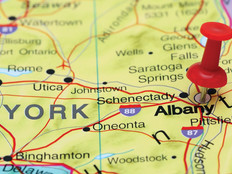Microsoft's Apps Help Tally Iowa Caucuses Results, With a Few Hiccups
The voting results are in, and so are the results of how Microsoft performed in its first go-round as a technology partner for the Iowa caucuses. For the most part, the software firm’s vote-tallying applications and its cloud service seemed to hold up and function properly, but the websites Microsoft set up to display the results crashed several times last night amid intense traffic spikes.
The first votes in the 2016 presidential election are now officially tallied, with Sen. Ted Cruz (R-Texas) winning the Republican contest ahead of Donald Trump and Sen. Marco Rubio (R-Fla.) and Hillary Clinton, the former secretary of state, narrowly defeating Sen. Bernie Sanders (I-Vt.) in the Democratic race. Microsoft had a hand in tabulating the results from the Hawkeye State.
Microsoft announced in June that for the 2016 caucuses, it would deploy “a new, mobile-enabled, cloud-based platform that will facilitate accuracy and efficiency of the reporting process.”
As CBS News notes: “Microsoft's new apps come four years after vote-counting problems bedeviled the Iowa Republican caucus. In the 2012 race, Mitt Romney appeared to be the Iowa winner for weeks, by a margin of just 8 votes, only for the final tally to show a narrow victory for Rick Santorum instead.”
Building a New System
As Microsoft explained in a YouTube video in June, in the past, local voting precincts reported vote tallies to the headquarters of the Iowa Democratic and Republican parties through “a network of automated telephone surveys,” with paper forms as a backup. The caucuses comprise 1,681 voting precincts, and Microsoft notes in the video that there was “no real verification that the results entered were actually accurate” and that human error could lead to inaccurate vote totals being reported, which could significantly affect the results.
Microsoft, through its partnership with custom application developer Interknowlogy, released smartphone and tablet apps for iOS, Android and Windows devices to allow authorized and authenticated caucus chairpersons to record and report the results. Microsoft created separate apps for the Republican and Democratic caucuses, since they have different processes, and the software firm vowed that none of the data would be co-mingled or shared externally. Each party also had a separate results verification app to monitor the results and look for anomalies so state party officials could be connected quickly to local precinct officials.
Microsoft also set up separate Republican and Democratic websites to report the results to the public and news organizations and let anyone see the results by county and precinct. Party officials got their own private view of the data with more details. Microsoft said the results would be securely stored and managed in its Azure cloud platform.
The Results Come in
As USA Today reported, some people took to Twitter last night to note that they could not access the reporting websites. Some who tried to check the sites were greeted with a message that said, “The service is unavailable.”
Microsoft said in a statement that its mobile apps for both parties worked “without issue.”
However, Microsoft blamed unusually large amounts of traffic for the website failures. “National interest in the Iowa Caucuses has overwhelmed the Democratic and Republican Party Iowa Caucus websites,” the company said. By Tuesday, the sites were working normally.
The New York Times, citing data from Edison Research, reported that turnout in the Republican caucuses was record-breaking, with around 185,000 voters casting ballot. Another Times report, citing Iowa Democratic Party officials, said turnout on the Democratic side was 171,109, far below the roughly 240,000 people who participated in the Democratic caucuses in 2008.









